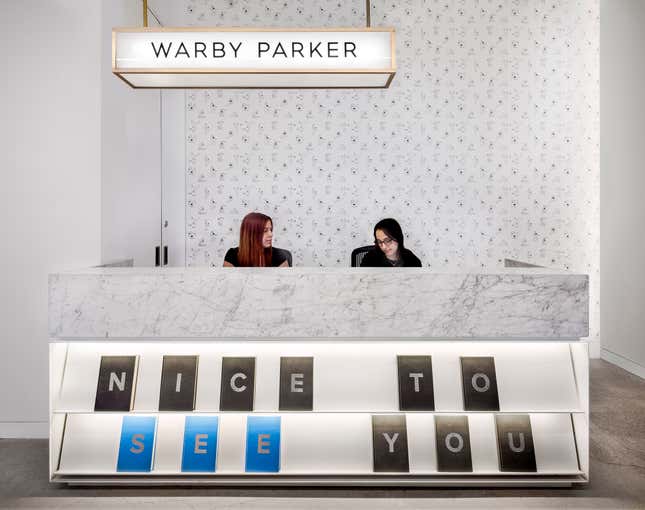The problem Warby Parker faced was not unusual nor particularly complicated: How could the trendy eyewear company make better use of its computer programmers’ time?
To solve that mundane quandary, the company could have hired an outside consultant, or reorganized its engineering department.
Instead, Warby Parker did something radical: It let its employees decide.
The company invented a process that invites all of its 800 workers to help manage the business. The new system, called Warbles, lets employees across Warby Parker nominate programming projects. Managers vote on them by assigning points to the tasks they think would add the most value. The programmers then get to pick the projects they’re most interested in, but they’re rewarded if they pick the ones with the most points. Teams of computer engineers compete to accumulate the most points, and after every quarter, the winning team gets a prize.
Warbles has been in place for about two years, and it’s illustrative of how the workplace is being reorganized. Once bastions of command-and-control culture, US companies are increasingly willing to experiment with structures that give employees more say in their work. From online retailer Zappos, which was an early adopter of a system of dismantling hierarchy called Holacracy, to Google, where employees can write their own job descriptions, the structure and shape of the firm is being renegotiated on multiple fronts.
At Warby Parker, the Warbles process is used for tasks as simple as correcting typos on the website to jobs as complex as building a system that lets customers select glasses online and try them in a store.
Prior to Warbles, the company assigned work to its more than two dozen computer engineers in its systems development department from the top down. They weren’t given a choice in their tasks, and the system wasn’t flexible enough to adjust to changing company priorities.
To find a better system, Warby Parker asked members of its tech team to separate into groups and propose new ideas. Separately, two groups came up with the concepts behind Warbles.
Warbles “ensures we’re getting a lot of value out of the tech team,’’ says co-CEO Dave Gilboa. And, he says, “Our engineers are much happier; they love the idea that they have autonomy and they can select ideas that they find most interesting.” Gilboa is used to working through consensus and group decision-making; he started Warby Parker in 2010 with three co-founders, all classmates from Wharton, and shares the CEO title with one of them, Neil Blumenthal.

Empowering workers isn’t just a trend for startups. At PwC, the accounting and consulting giant that dates to 1849, more and more authority is being given to front-line employees who work with clients, says Tim Ryan, the chairman of the firm’s US practice.
“If you have a highly skilled workforce, I don’t think command-and-control works,” he says. Ryan would rather give employees autonomy and take his chances with the occasional wrong decisions. He notes there are very few decisions any one employee can make to seriously damage PwC, but a culture of indecision and buck-passing can kill it.
There are other sound financial reasons for businesses to tap their employees’ knowledge. In a study that looked at how Cirque du Soleil came up with new acts, Stanford University business professor Justin Berg found that the circus workers were significantly better than their bosses at predicting which new acts would be successful.
Berg argues that as managers move up the corporate ranks, they have less exposure to new ideas, and are more committed to ideas that worked in the past. Warbles, then, allows more ideas to surface, and be heard by more managers.
“Rather than pitching their new ideas to one or two managers, employees can test their ideas with everyone in the company, which may help them win support for their ideas that they wouldn’t have received otherwise,” Berg says.
The voting process to prioritize the work is designed to correct for the potential downside of having too many ideas simultaneously pulling the company in different directions.
“More minds in the room”
Undergirding the idea of crowdsourcing is the belief that diversity is a strength, and that the more perspectives that are brought to a problem, the more potential there is for solutions to be found. The concept is centuries old—in the 18th century the English government held a contest to find a way to determine longitude at sea, which successfully solved a problem that bedeviled mariners for centuries. But the opportunities to use such an approach have exploded in recent years as the internet makes it simple to connect huge numbers of people.
Crowdsourcing is a particularly valuable tool for unearthing rare and extraordinary ideas, the “right tail” of a bell curve, not the run-of-the-mill ideas that make up the bulge in the middle, says Ethan Bernstein, a Harvard Business School professor who writes about organizational behavior.
“They’re solving more problems and they’re solving them better, because they have more minds in the room, no matter how they get them in the room,” he says.
And more companies are using it as a business tool. IBM began crowdsourcing internally to generate ideas, and now markets its InnovationJam as a service to customers. Companies who use it enlist hundreds of employees to thrash out concepts in online discussions, which IBM filters through analytic software.
The self-directed workplace
Warbles also shares some of the self-directed principles of Holocracy, which—when it works—creates efficiency by giving autonomy to employees who can make better decisions than bosses.
Holocracy has its detractors, who see traditional hierarchies replaced with a stifling, cumbersome structure of concentric team circles, and at Zappos, perhaps its best-known adherent, there have been public growing pains.
Bernstein argues it makes more sense to blend elements of self-management with traditional structures. Warbles is an example of that hybrid—it allows managers to shape the flow of the work, but gives programmers freedom to pick the projects where they know they can excel. “It’s a very novel prioritization scheme,” says Bernstein, noting that in the project-selection phase, “the execution is self-organized but the organization is not.”
Warbles at work
Earlier this year, Warby Parker used Warbles to add a new feature to its website that let customers select favorites by clicking on a heart icon, and revisit them later. The favorites option builds off another feature, called bookmarks, which let customers select glasses in a store, then buy them online at home.
The idea for favorites, first raised by Tim Riley, the director of online experience, was submitted as a ticket via the internal Warbles website in January. Like all the ideas, it was vetted to see how much it would cost versus what it could save, and the task was assigned a size “L.” (Like t-shirts, Warbles ideas are labeled either S, M, L, or XL, based on how much time and work it will take to complete them).
The ticket was then added to the internal Warbles app, where it sat for almost two weeks with about 50 other tasks collecting votes. While all the company’s employees can submit ideas, only 31 managers can vote, says Lon Binder, Warby Parker’s chief technology officer. That ensures decisions are made by people who can see across the entire organization, and hopefully eliminates parochial voting, he says.
Managers vote by assigning “upvotes” or “downvotes” to the task, depending on whether they think have value. Everyone can see what everyone else is voting on. Most voters get five points, called Warbles, per up vote, while CEOs get 10, 20, or 30.

The bosses can steer the process, but they can’t control it. “There are some ideas from CEOs that haven’t gotten traction,” says Todd O’Brien, who manages the programming teams that use Warbles.
To be sure, the business is not run entirely at the whim of its developers. Managers will eventually assign any projects that are high priority, but which no one has grabbed. And they also try to ensure that any engineer who takes a task has the specific skills required to complete it, or can learn them.
After about two weeks on the Warbles site, the idea for the favorites feature had garnered 80 Warbles, a sizable amount for a large project. Kevin Pruett, a recently hired web developer looking for a new task, noticed how many points it had and grabbed it at the urging of his manager. The high Warbles score signaled there was company-wide interest, and he said the project appealed to him personally.
By April, after months of coding, a beta version of the favorites button launched, with half of the website’s users seeing it. It proved so popular that it quickly became a permanent addition to the site. Warby Parker is now working on a companion system that lets store clerks pull up customer favorites so they can try them on in the store.
The favorites project helped Pruett’s team score 383 Warbles, the most in the first quarter, beating the second-place team by 36. The winners were invited to celebrate at a team dinner.
Since the introduction of Warbles, thousands of ideas have been submitted and hundreds have been enacted. The process means everyone in the organization knows what tasks are being tackled, so there’s less griping when someone’s cherished project isn’t being worked on, says O’Brien, the features development manager.
Programmers prefer it to the previous systems, too. In an internal survey, when the engineers were asked if they would recommend Warbles, they rated it 8.3 out of 10, compared to 3.5 for the earlier process.
Gilboa says the company is thinking about applying the concept to other areas of Warby Parker, and is even considering offering it to other companies for free.
When the process works, programmers are motivated and are working on the projects the company has prioritized. And when it doesn’t work? “At the end of the day it’s a company,” says Binder, the CTO, “so if it needs to get done, Todd [O’Brien] will come in and tell them to do it.”
This article has been updated to clarify that the more than two dozen programmers who take part in the Warbles program are in the systems development team. Warby Parker has other programmers who aren’t in Warbles.




